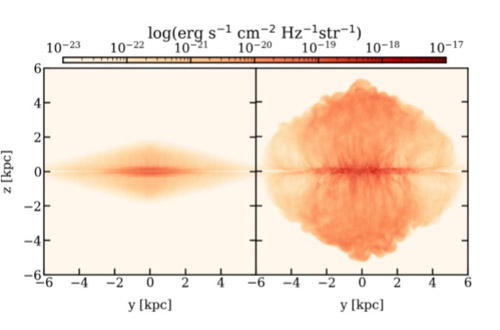 Galaxies, like all other celestial objects, emit light in many ‘colours’ or wavelengths. The emission in radio wavelengths, however, has a special significance for astronomers. Their radio ‘images’ show a diffuse glow that extends far beyond the stars in those galaxies. If only one could image them in radio wavelengths, we could have detected radio signals from regions above the discs of galaxies.
Galaxies, like all other celestial objects, emit light in many ‘colours’ or wavelengths. The emission in radio wavelengths, however, has a special significance for astronomers. Their radio ‘images’ show a diffuse glow that extends far beyond the stars in those galaxies. If only one could image them in radio wavelengths, we could have detected radio signals from regions above the discs of galaxies.
This extended glow arises from high energy electrons that spiral around magnetic field. The question that have puzzled astronomers is the mechanism by which such high energy electrons are lifted above the body of the galaxy. Previous studies have shown that the greater the rate of star formation in a galaxy, the more extended is its radio glow. Therefore, the process of formation of star is the cause of the diffuse glow. But the precise connections and the detailed physical mechanisms have eluded astrophysicists so far because of the complexity of the process.
New simulations, carried out by Aditi Vijayan, a PhD student at Raman Research Institute (an autonomous institute of the Department of Science & Technology) and Indian Institute of Science, show in detail that exploding stars (which must occur as a result of star formation) disturb the gas in a galaxy in such a way as to lift the gas out of the galaxy, as well as its magnetic field and high energy particles. Their simulated radio ‘images’ can explain the earlier observations of the extent of the radio glow, for galaxies with different rates of star formation. In other words, the shape of the radio glow depends on the vigour of star formation.
The research has been published in the journal Monthly Notices of the Royal Astronomical Society (‘Radio halos of Star Forming Galaxies’, Vijayan et al, Issue 475, pages- 5513-5528, https://academic.oup.com/mnras/article-abstract/492/2/2924/5685966), is the result of collaborative work between researchers at RRI and Dr. Prateek Sharma (IISc, Bengaluru) and Prof. Yuri Shchekinov (Lebedev Institute, Moscow). Its main results concerns with studying the geometrical shapes of the radio halos in galaxies with varying degrees of star formation, using three dimensional computer simulations - a novel approach for understanding radio halos and their properties .
The simulations were performed using an astrophysical code called PLUTO. This code solves equations of conservation of mass, energy, and momentum for a given set of initial conditions. Some of the simulations were conducted using the supercomputer Sahasrat at IISc. To test subsequent prediction from their simulations, regarding the distribution of radio emission in galaxies, the team used Giant Metrewave Radio Telescope (GMRT) to look at the radio halo of NGC 4631 --- a nearby galaxy, similar to Milky Way in mass.
The researchers established a physically motivated setup, using parameters related to distribution of magnetic fields and stars, which could reproduce observable quantities. They conducted mock simulations, similar to controlled experiments undertaken by experimentalists, to fix these parameters for the production runs. Their work shows that there is a minimum rate of star formation required to produce an extended halo in the radio. Observations have indicated a threshold value of star formation, and their work provides a theoretical explanation for this.
Astronomers have known about the presence of radio halos since a few decades and have studied their shapes extensively. The connection between the shape of a radio halo and the galaxy, around which it is present, has been a long-standing puzzle. The team realised that their simulation setup holds the potential to address this question. Further, the presence of a nearby international facility for radio observations, that is, GMRT, motivated them to make testable predictions from the theoretical models.
One of the reasons why it is important to know the shape of radio glow is a puzzling excess of radio emission that was detected a few years ago, when one looks towards the poles of Milky Way galaxy. It is difficult to ascertain the origin of this excess emission using telescopes on Earth, since we are located inside the Milky Way, and embedded in its own radio glow. If the shape of the radio glow were to be roughly spherical, then the ‘excess’ would be due to Milky Way’s own radio emission. If not, then it would signify a different source, or set of sources, located outside our Galaxy.
Vijayan et al’s simulations show that the typical shapes of radio glows are likely to be ellipsoidal, rather than spherical. Therefore, it would appear that the excess radio emission cannot be explained by Milky Way emission, and its origin remains a puzzle.
The team believes that in the coming years, upcoming radio telescopes will be able to probe the radio sky with unprecedented resolution, and they will be able to study morphology of radio halos with great details.
The image shows the radio halo from the simulations. The colour bar on the top of the image shows surface brightness in typical units used by astronomers. The central disk of the galaxy is the brightest because it contains a lot of gas and magnetic field. The magnetic field in the extra-planar regions interacts with energetic electrons, which are also produced in the supernova explosions. This interaction creates radio halos around the galaxy. The image in the left panel shows what the galaxy looked at before any supernova explosions went off. The one on the right shows how the galaxy looks after 5 Million years of evolution.






























